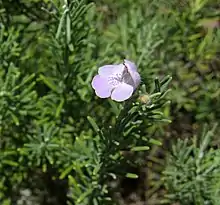Conradina canescens
Conradina canescens, commonly called false rosemary,[1] is a shrub in the mint family. It is native to the southeastern United States, where it is restricted to coastal areas of Alabama, Florida, and Mississippi.[2] Its natural habitat is sandhills, coastal scrub, and flatwoods.[3]
| Conradina canescens | |
|---|---|
 | |
| Scientific classification | |
| Kingdom: | Plantae |
| Clade: | Tracheophytes |
| Clade: | Angiosperms |
| Clade: | Eudicots |
| Clade: | Asterids |
| Order: | Lamiales |
| Family: | Lamiaceae |
| Genus: | Conradina |
| Species: | C. canescens |
| Binomial name | |
| Conradina canescens A.Gray 1870 | |
This species a shrub that produces light purple flowers. It is distinguished from other Conradina by its linear, revolute leaves that are densely gray-pubescent.[3]
References
- "Conradina canescens". Natural Resources Conservation Service PLANTS Database. USDA. Retrieved 21 December 2017.
- "Conradina canescens". County-level distribution map from the North American Plant Atlas (NAPA). Biota of North America Program (BONAP). 2014. Retrieved 21 December 2017.
- Alan Weakley (2015). "Flora of the Southern and Mid-Atlantic States".
This article is issued from Wikipedia. The text is licensed under Creative Commons - Attribution - Sharealike. Additional terms may apply for the media files.